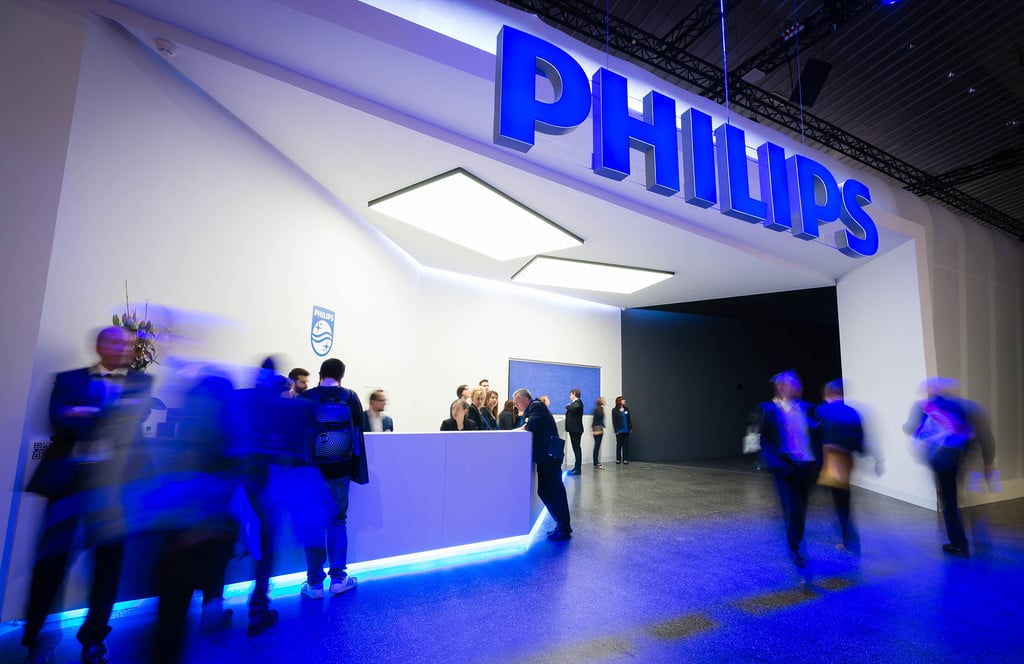
While the company focused on LED and other technological innovations in previous Light + Building events, this one, at least for Philips, was about connectivity and the Internet of Things (IoT).
 PHOTO: PHILIPS LIGHTING
PHOTO: PHILIPS LIGHTING"It's still about LED lighting, it's still about connected lighting, but we are extending our leadership in the Internet of Things to deliver unique benefits to our customers," Philips Lighting CEO Eric Rondolat said at a press conference held on March 14. "It's about enhanced quality of light, it's about even greater energy savings, but it's also about unlocking new value from Internet of Things apps and services."
 PHOTO: PHILIPS LIGHTING
PHOTO: PHILIPS LIGHTINGIn the past 10 years, Rondolat went on, the lighting industry has changed more than it did in the past century. By 2030, he estimated, there will be 70% more light points than today. "We need more energy efficient light; there is a climate change equation that we are participating with."
"We are only scratching the surface when it comes to what can be done when we connect light the way we have described today," he said. "We see ourselves as the lighting company for the internet of things."
Professional lighting
Have you ever come across street lights that are switched on during the day? Or broken street lights that don't get fixed for months? Latest technological advances are at the brink of making these inefficiencies history, and Philips is gearing to carve its share of the connected lighting market.
Speaking about the road and street segment, Philips Lighting's Professional division CEO Dominiek Plancke said that roughly 10% of all the light points today were equipped with LED, but only 2% of them were connected. "So how can we accelerate connectivity? We developed CityTouch connector node which we applied for the first time on 110,000 luminaires in the city of LA."
 PHOTO: PHILIPS LIGHTING
PHOTO: PHILIPS LIGHTINGThe Philips CityTouch connector node is a wireless plug-n-play device that helps connect street lights from any manufacturer to the CityTouch cloud-based software. The application allows a city's lighting managers to manage, maintain and monitor every individual light point. The smart device that has a SIM card and is capable of geo-location allows for "30% more energy saving, on top of the 40% that you're already getting through the adoption of LED," according to Plancke.
Plancke added that the technology had been deployed in 530 projects across 33 countries and that had given the company a lot of insights, including some of their clients' concerns. "They are asking for systems that are scalable but also future-proof."
 PHOTO: PHILIPS LIGHTING
PHOTO: PHILIPS LIGHTINGTo this end, the company introduced DigiStreet, a new range of street lighting luminaires that have slots that will allow city lighting managers in the future to connect photocells, CityTouch wireless connector nodes, or various other kinds of sensors.
"This gives them the optionality to deploy LED first and then later switch to the company's CityTouch system," Plancke said. "We are giving optionality to cities so that they can migrate towards their vision of a smart city at their own pace."
Plancke announced Philips Lighting's global partnership with British telecom giant Vodafone, under which the two companies will enable cities around the world to implement connected street lighting wirelessly, and the company's first ever connected lighting indoor positioning implementation in the Middle East, a partnership with UAE-based retailer Aswaaq. Under the partnership, Philips Lighting, in partnership with US-based shopper analytics firm Aisle411, will help the retailer boost sales by providing a connected lighting indoor positioning system.
Philips Lighting had sales of $8.37 billion in 2015 of which $3.62 billion was from digital lighting.
 PHOTO: PHILIPS LIGHTING
PHOTO: PHILIPS LIGHTINGAdvantages for developing countries
The advantage of these technologies for countries like Pakistan is that they can start small and then scale, Philips Lighting's Global Lighting Systems SVP Jeff Cassis said on the sidelines of the trade show while speaking to journalists.
"Some of the developing countries actually are some of the more progressive," Cassis said. "They have less infrastructure and less challenges, and they make decisions very quickly, which I think is very important."
Cassis added that solar energy was another application that was quite impressive in developing countries. "I think developing markets are an excellent place to start."
Home business
Philips Lighting Home division CEO Chris Worp announced new partnerships for the company's Hue home lighting system with a Dutch telecom company, and French insurance and energy companies in a bid to drive the adoption of the IoT for homes. The division represents 25% of the company's business.
 PHOTO: PHILIPS LIGHTING
PHOTO: PHILIPS LIGHTINGWorp also introduced SceneSwitch, a 3-in-1 light bulb that allows for natural light, bright light and warm light, using the standard switch that most of us have at home. The company also unveiled a LED spot that look and feels like a halogen spotlight, but is 90% more energy efficient.
LED, it seems, is becoming the lighting standard, at least in developed economies. The only qualm that consumers in developing countries seem to have is the upfront cost of the comparatively expensive LED bulbs as opposed to the common fluorescent light bulbs and tubes. The other challenge, specific to Philips Pakistan, is the infiltration of what the company claims are sub-standard Chinese imports and the lack of standards implementation by authorities here.























COMMENTS
Comments are moderated and generally will be posted if they are on-topic and not abusive.
For more information, please see our Comments FAQ